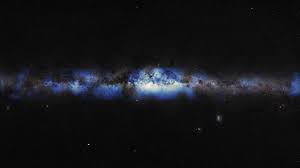Ghost Particles :New Picture Of Our Galaxy

Scientists have recently revealed a new picture of our galaxy: made up of invisible “ghost particles” that have not been detected until now.
- Neutrinos are tiny subatomic particles, often called ‘ghost particles’ because they barely interact with anything else.
- Neutrinos come from all kinds of different sources and are often the product of heavy particles turning into lighter ones, a process called “decay.”
- Neutrinos are denoted by the Greek symbol ν, or nu (pronounced “new”).
- They belong to the family of particles known as leptons.
- There are three main leptons, namely electrons, muons and tau particles, and each one has an associated neutrino and anti-neutrino.
- A neutrino is very similar to an electron but has no electrical charge and a very small mass.
- They are the most common particle in the universe. Approximately 100 trillion neutrinos pass completely harmlessly through the human body every second.
- They are extraordinarily difficult to detect, as they rarely collide with atoms.
- Of the four fundamental forces in the universe, neutrinos only interact with two — gravity and the weak force.
- But not all neutrinos are the same.
- They come in different types and can be thought of in terms of flavours, masses, and energies.




